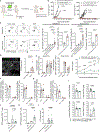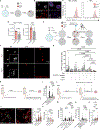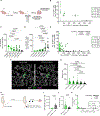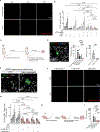Immune evasion of dormant disseminated tumor cells is due to their scarcity and can be overcome by T cell immunotherapies
- PMID: 38194912
- PMCID: PMC10864018
- DOI: 10.1016/j.ccell.2023.12.011
Immune evasion of dormant disseminated tumor cells is due to their scarcity and can be overcome by T cell immunotherapies
Abstract
The period between "successful" treatment of localized breast cancer and the onset of distant metastasis can last many years, representing an unexploited window to eradicate disseminated disease and prevent metastases. We find that the source of recurrence-disseminated tumor cells (DTCs) -evade endogenous immunity directed against tumor neoantigens. Although DTCs downregulate major histocompatibility complex I, this does not preclude recognition by conventional T cells. Instead, the scarcity of interactions between two relatively rare populations-DTCs and endogenous antigen-specific T cells-underlies DTC persistence. This scarcity is overcome by any one of three immunotherapies that increase the number of tumor-specific T cells: T cell-based vaccination, or adoptive transfer of T cell receptor or chimeric antigen receptor T cells. Each approach achieves robust DTC elimination, motivating discovery of MHC-restricted and -unrestricted DTC antigens that can be targeted with T cell-based immunotherapies to eliminate the reservoir of metastasis-initiating cells in patients.
Keywords: CAR T cell; T cell; TCR T cell; breast cancer metastasis; disseminated tumor cells; immune evasion; immunotherapy; tumor dormancy; tumor microenvironment; vaccine.
Copyright © 2023 Elsevier Inc. All rights reserved.
Conflict of interest statement
Declaration of interests S.R.R. is a co-founder of Lyell Immunopharma, has research funding from Lyell Immunopharma, and holds equity in Lyell Immunopharma. S.R.R. has patents in the field of cellular therapy unrelated to this work licensed to Juno Therapeutics/Bristol Myers Squibb and Lyell Immunopharma. M.H.L. has served as a consultant for Scribe Biosciences, Inc. S.S. has received research funding from Lyell Immunopharma, has a patent licensed by Lyell Immunopharma, holds equity and has served as a consultant for Lyell Immunopharma outside the submitted work. J.R.V. has intellectual property unrelated to this work licensed to Lyell Immunopharma and has received research grant support form Lyell Immunopharma and Bristol Myers Squibb.
Figures





Comment in
-
Immune evasion by dormant disseminated cancer cells: A Fermi paradox?Cancer Cell. 2024 Jan 8;42(1):13-15. doi: 10.1016/j.ccell.2023.12.017. Cancer Cell. 2024. PMID: 38194913 Free PMC article.
References
-
- Karrison TG, Ferguson DJ, and Meier P (1999). Dormancy of mammary carcinoma after mastectomy. Journal of the National Cancer Institute 91, 80–85. - PubMed
Publication types
MeSH terms
Grants and funding
LinkOut - more resources
Full Text Sources
Medical
Research Materials

